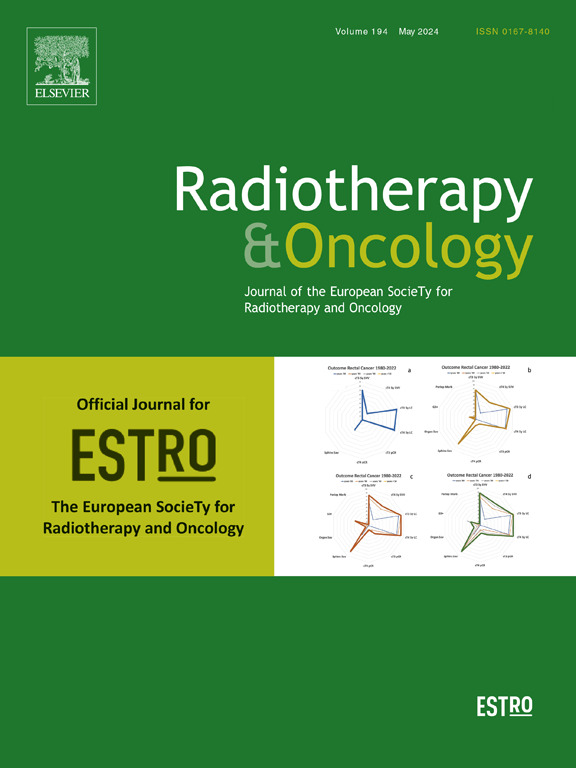Evaluating the prognostic significance of artificial intelligence-delineated gross tumor volume and prostate volume measurements for prostate radiotherapy
IF 4.9
1区 医学
Q1 ONCOLOGY
引用次数: 0
Abstract
Background and purpose
Artificial intelligence (AI) may extract prognostic information from MRI for localized prostate cancer. We evaluate whether AI-derived prostate and gross tumor volume (GTV) are associated with toxicity and oncologic outcomes after radiotherapy.
Materials and methods
We conducted a retrospective study of patients, who underwent radiotherapy between 2010 and 2017. We trained an AI segmentation algorithm to contour the prostate and GTV from patients treated with external-beam RT, and applied the algorithm to those treated with brachytherapy. AI prostate and GTV volumes were calculated from segmentation results. We evaluated whether AI GTV volume was associated with biochemical failure (BF) and metastasis. We evaluated whether AI prostate volume was associated with acute and late grade 2+ genitourinary toxicity, and International Prostate Symptom Score (IPSS) resolution for monotherapy and combination sets, separately.
Results
We identified 187 patients who received brachytherapy (monotherapy (N = 154) or combination therapy (N = 33)). AI GTV volume was associated with BF (hazard ratio (HR):1.28[1.14,1.44];p < 0.001) and metastasis (HR:1.34[1.18,1.53;p < 0.001). For the monotherapy subset, AI prostate volume was associated with both acute (adjusted odds ratio:1.16[1.07,1.25];p < 0.001) and late grade 2 + genitourinary toxicity (adjusted HR:1.04[1.01,1.07];p = 0.01), but not IPSS resolution (0.99[0.97,1.00];p = 0.13). For the combination therapy subset, AI prostate volume was not associated with either acute (p = 0.72) or late (p = 0.75) grade 2 + urinary toxicity. However, AI prostate volume was associated with IPSS resolution (0.96[0.93, 0.99];p = 0.01).
Conclusion
AI-derived prostate and GTV volumes may be prognostic for toxicity and oncologic outcomes after RT. Such information may aid in treatment decision-making, given differences in outcomes among RT treatment modalities.
评估人工智能描述的总体肿瘤体积和前列腺体积测量对前列腺放疗的预后意义。
背景和目的:人工智能(AI)可从磁共振成像中提取局部前列腺癌的预后信息。我们评估了人工智能得出的前列腺体积和肿瘤总体积(GTV)是否与放疗后的毒性和肿瘤预后相关:我们对 2010-2017 年间接受放疗的患者进行了回顾性研究。我们训练了一种人工智能分割算法,以勾画接受体外射束 RT 治疗的患者的前列腺和 GTV 的轮廓,并将该算法应用于接受近距离放射治疗的患者。根据分割结果计算出人工智能前列腺和GTV体积。我们评估了AI GTV体积是否与生化失败(BF)和转移有关。我们分别评估了前列腺AI体积是否与急性和晚期2级以上泌尿生殖系统毒性以及单药治疗组和联合治疗组的国际前列腺症状评分(IPSS)分辨率有关:我们确定了187名接受近距离治疗的患者(单一疗法(154人)或联合疗法(33人))。AI GTV 量与 BF 有关(危险比 (HR):1.28[1.14,1.44];p 结论:AI GTV 量与 BF 有关:AI 导出的前列腺体积和 GTV 体积可能是 RT 治疗后毒性和肿瘤结果的预后指标。鉴于不同 RT 治疗模式的结果存在差异,这些信息可能有助于治疗决策。
本文章由计算机程序翻译,如有差异,请以英文原文为准。
求助全文
约1分钟内获得全文
求助全文
来源期刊

Radiotherapy and Oncology
医学-核医学
CiteScore
10.30
自引率
10.50%
发文量
2445
审稿时长
45 days
期刊介绍:
Radiotherapy and Oncology publishes papers describing original research as well as review articles. It covers areas of interest relating to radiation oncology. This includes: clinical radiotherapy, combined modality treatment, translational studies, epidemiological outcomes, imaging, dosimetry, and radiation therapy planning, experimental work in radiobiology, chemobiology, hyperthermia and tumour biology, as well as data science in radiation oncology and physics aspects relevant to oncology.Papers on more general aspects of interest to the radiation oncologist including chemotherapy, surgery and immunology are also published.
 求助内容:
求助内容: 应助结果提醒方式:
应助结果提醒方式:


